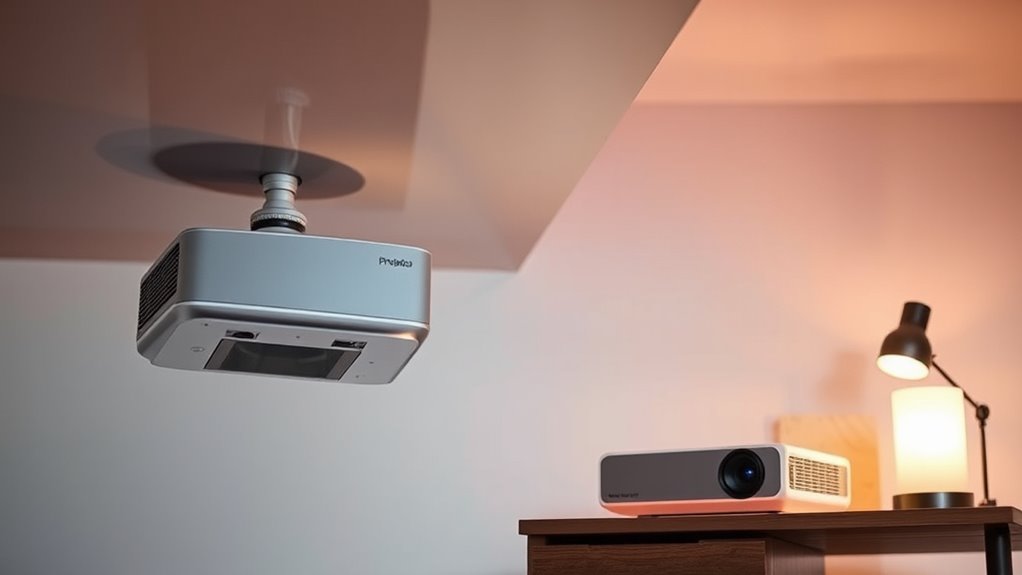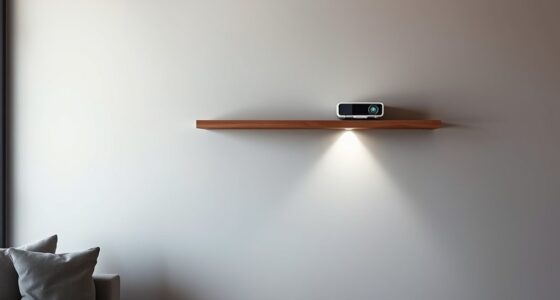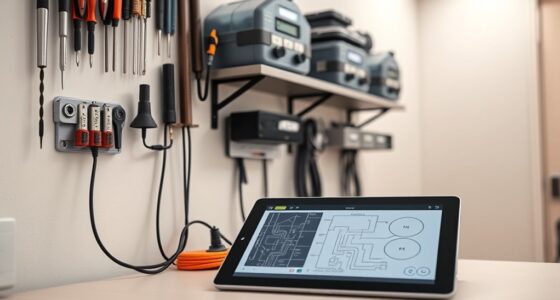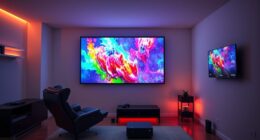When choosing between ceiling mounts and tabletop placement, consider your space and needs. Ceiling mounts create a sleek, clutter-free look and save space, which is great for art displays and tight areas. However, they’re more complex to install and harder to maintain. Tabletop setups are easier to access and adjust but can cause clutter and are more vulnerable to knocks. Keep exploring to find out which option suits your environment best.
Key Takeaways
- Ceiling mounts save space and provide a sleek, modern look, ideal for art displays and clutter reduction.
- Tabletop placements offer easier access for adjustments, troubleshooting, and casual viewing.
- Ceiling mounting involves complex installation and potential maintenance challenges, increasing costs.
- Tabletop setups are more vulnerable to spills, knocks, and limited surface space.
- The choice depends on environment needs, with ceiling mounts suited for aesthetics and space-saving, and tabletop for accessibility and flexibility.

When choosing between ceiling mount and tabletop placement for your device or equipment, understanding the advantages and limitations of each option is essential. If you’re working on an art installation or setting up a display, your choice impacts not only aesthetics but also how well you optimize your available space. Ceiling mounts can create a sleek, modern look that keeps your surface area clear, making the environment feel less cluttered and more open. This setup allows you to position equipment overhead, freeing up valuable tabletop real estate for other purposes. It’s particularly useful in tight spaces or when you want to maintain a clean, minimalist appearance. Conversely, tabletop placement offers straightforward access and easy adjustments. If you frequently need to interact with your device, such as for troubleshooting, calibrating, or casual viewing, placing it on a table or desk can be more convenient. It’s also ideal for temporary setups or art installations where quick changes or repositioning are necessary.
However, each option has its limitations. Ceiling mounts require more installation effort and may involve ceiling reinforcement, which can be costly and complex. You need to contemplate the weight and size of your equipment to ensure the mount can support it safely. Additionally, ceiling-mounted devices can be harder to access for maintenance or troubleshooting. They may also cast shadows or cause glare, which could interfere with art installations or presentations. On the other hand, tabletop placements can lead to cluttered surfaces, reducing available space for other activities or displays. If you’re working with limited tabletop area, placing multiple devices or equipment might become problematic, hampering space optimization. Also, tabletop setups are more vulnerable to accidental knocks or spills, which could damage sensitive equipment or disrupt your display. Furthermore, understanding emotional support can be crucial if your setup involves stress or frustration related to technical issues or installation challenges.
Choosing the right mounting option ultimately depends on your specific needs and environment. If your priority is a clean aesthetic and maximizing space, ceiling mounting might be the better choice. It’s especially effective for art installations where visual impact and space efficiency matter. If you prefer accessibility, flexibility, or ease of setup, tabletop placement could serve your purposes better. Think about how often you need to interact with the device, the nature of your display or installation, and the space constraints you face. Both options have their pros and cons, but understanding how they align with your goals will help you make the most effective decision.
Frequently Asked Questions
Which Mounting Option Is More Cost-Effective Long-Term?
Ceiling mounting is more cost-effective long-term because it offers greater installation flexibility and often requires less maintenance. You save on replacement costs and can easily adjust the setup to fit your space, enhancing aesthetic appeal without frequent updates. Tabletop options may seem cheaper initially, but they tend to be less durable and need more frequent repositioning or replacement, making ceiling mounts the smarter, more economical choice over time.
How Do Mounting Choices Affect Device Maintenance Access?
Your mounting choice considerably impacts device maintenance access. Ceiling mounts offer limited installation flexibility, making maintenance more challenging, especially if fixtures are hard to reach. In contrast, tabletop placements provide easier access, simplifying upkeep and repairs. Additionally, ceiling mounts can affect the aesthetic impact, potentially making maintenance less visually intrusive. Consider your space and maintenance needs when choosing between these options to ensure smooth operation and minimal disruption.
Are There Specific Safety Considerations for Ceiling Mounts?
Think of ceiling mounts as the foundation of a skyscraper—you need solid installation safety to prevent accidents. Always check structural concerns like ceiling strength and weight capacity before mounting. Make certain secure fastening and consider environmental factors like vibrations or potential impacts. Properly following installation safety guidelines minimizes risks, keeping both your device and people safe. Don’t overlook these safety considerations—they’re essential for a stable, secure ceiling mount.
Can Both Options Be Used Interchangeably?
You can’t really use ceiling mount and tabletop placement interchangeably because they offer different adjustment flexibility and involve varying installation complexity. Ceiling mounts typically provide more adjustable angles but require more complex installation, while tabletop setups are easier to set up but offer limited flexibility. Consider your space, safety needs, and how often you might need to adjust the device before choosing the best option for your situation.
How Does Mounting Impact Device Lifespan and Durability?
Like a knight’s armor, your mounting choice influences device lifespan and durability. Ceiling mounts often offer better installation flexibility, reducing wear from accidental bumps, while tabletop options are more prone to damage but easier to replace or repair. Both methods impact how well your device withstands environmental factors and aesthetic integration, so consider your space and usage habits to maximize durability and longevity.
Conclusion
Choosing between ceiling mount and tabletop placement is like deciding whether to hang a painting high on the wall or place it on a prominent shelf. I once struggled with this myself—initially thinking the ceiling mount was too intrusive, but it turned out to save space and offer a sleek look. Consider your needs, space, and style. Just like art, your mounting choice should reflect your space and how you want to experience it daily.









